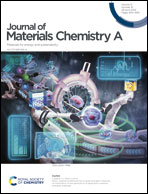Modifying cellular properties via rational chemical design for unnatural oxygen reduction electrocatalysis of a cell†
Abstract
It is of great theoretical and practical significance to break through the evolution of natural cells and confer new catalytic properties via chemical modification to catalyze unnatural chemical reactions in biocatalytic synthesis. However, at present, the development of new methods and structures for chemically modifying a whole cell so that it possesses unnatural catalytic functions is currently in its initial stages. Herein, we rationally designed and constructed a nanohybrid whole cell to catalyze an unnatural oxygen reduction reaction (ORR) in the cathode of a microbial fuel cell (MFC) via modification of proteins in cells with in situ-generated nanocomplexes, and the cell acquired the dual functions of power generation and pollutant degradation. Guided by theoretical calculations, we demonstrated that Escherichia coli cells containing cytochrome c (Cyt c) modified by iron–tannic acid (Fe–TA) nanocomplexes engaged in excellent unnatural electrocatalytic ORR activity and pollutant degradation. The obtained microbial catalyst exhibited a remarkable ORR performance with a maximum current density of 3.1 mA cm−2 and an onset potential of 0.66 V, which is significantly superior to the level of biotic and abiotic catalysts reported thus far. A maximum power density for the assembled MFC of 301 μW cm−2 was obtained, with glucose degradation at 18 mM in 120 h, and these values were comparable with world-class standards. For the first time, to the best of our knowledge, a cathode catalyst was utilized to simultaneously generate electricity and degrade pollutants. Finally, the catalytic mechanism was explored in detail using a series of experimental tests, including protein analysis, XPS, and NMR. The results revealed that the binding proteins of the nanocomplexes, the catalytic active sites, the interacting atoms, and the regulatory mechanisms of coordination substitution and electron-donating activation, e.g., the Fe–TA nanocomplexes, enabled regulation of the electronic structure of Cyt c proteins. This promoted the charge transfer of the Fe center, which resulted in the ability of Cyt c to increase its adsorption and activation of O2. This work offers a new design strategy to endow microbial cells with unnatural catalytic functions.



 Please wait while we load your content...
Please wait while we load your content...